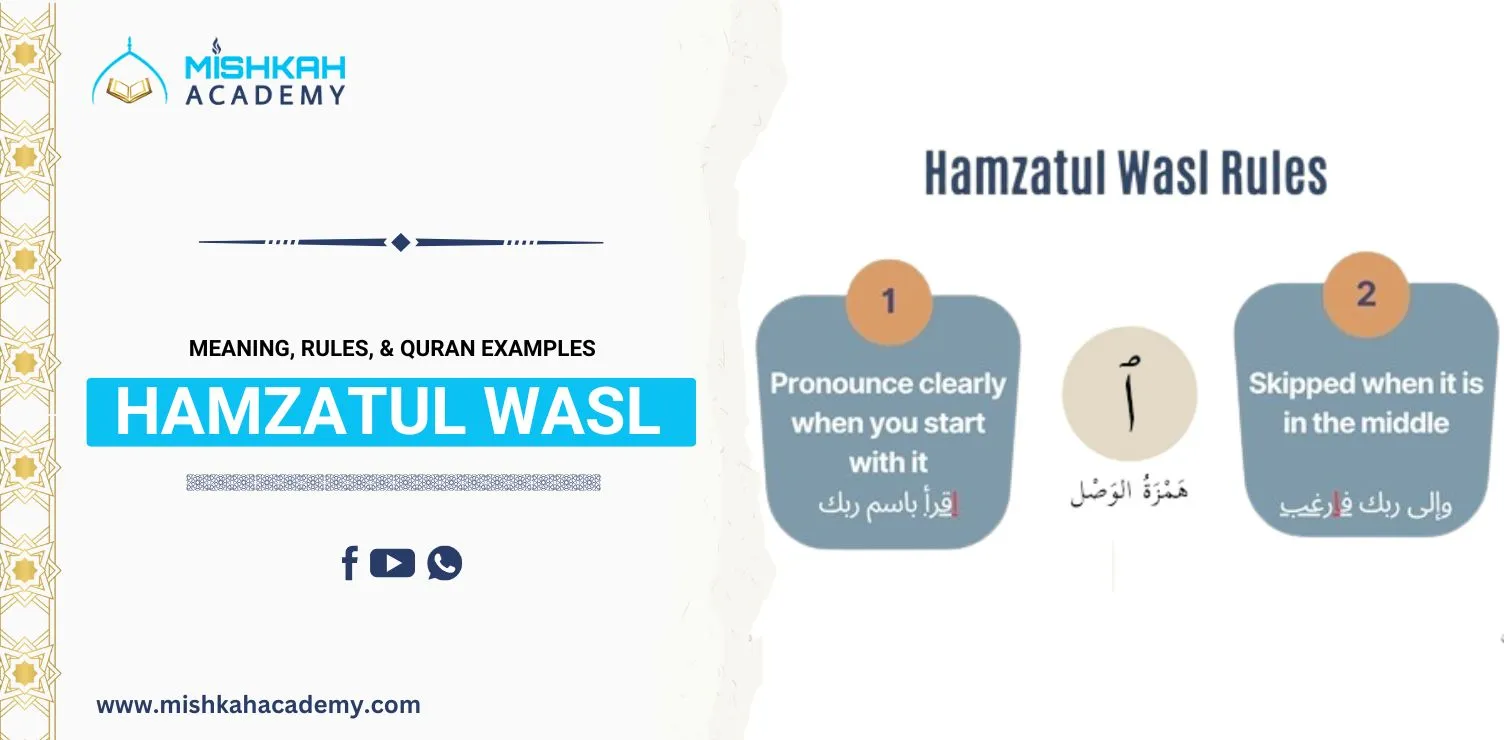A key component of the Arabic language, Hamzatul Wasl (همزة الوصل) focuses on how words should be pronounced when reading and reciting, especially when reciting the Qur’an. Known as the “connecting Hamzah” in Arabic grammar, it improves the pronunciation of words when they are joined. To become proficient in Tajweed, or the art of reciting the Qur’an, and to read Arabic fluently, one must study Hamzatul Wasl.
Though Hamzatul Wasl can be written ٱ, it is normally indicated by the plain Alif without a Hamzah. It occurs in short words with two of their 3-consonant roots apparent like (اسْم), (ابْن), (امْرُؤ), (اثْنَانِ). Also, it occurs in some words that begin with consonant clusters, and imperative verbs of forms (البَيْتُ الكَبِير).
In order to show the importance of Hamzatul Wasl in Arabic phonetics and language, this article will examine its definition, rules, and types while using examples from the Qur’an.
Definition of Hamzatul Wasl?
Table of Contents
ToggleWhen words are joined in the middle of a word, the final Hamzah known as Hamzatul Wasl is removed from pronunciation but aids in introducing words when needed. Mostly found at the start of words, it is only pronounced when the word it starts is the first word in a sentence or phrase. To keep speech fluid, the Hamzah is omitted if one word comes after another.
Wasl, which means to “connection,” suggests that the Hamzah is not a fixed, independent sound but rather is linked to the speech flow. When not in an initial position, Hamzatul Wasl goes missing in contrast to Hamzatul Qat’ (همزة القطع), which is always pronounced no matter its position.
Hamzatul Wasl Rules
Hamzatul Wasl is pronounced according to a number of principles and is dependent on certain linguistic circumstances. The following are the basic rules that decide when and how to pronounce Hamzatul Wasl:
-
Pronunciation at the Beginning of a Sentence
The Hamzah happens when a word beginning with Hamzatul Wasl appears at the start of a sentence. In some situations, the Hamzah is spoken with the aid of a vowel sound (harakah).
The word’s third letter determines the harakah that is utilized. For instance, the Hamzah will be pronounced with kasra (ِ).if the third letter contains a fatha (َ). The Hamzah will be pronounced with a damma (ُ),if the third letter contains one.
-
Omission in the Middle of a Sentence
The Hamzah is missing from pronunciation if the word that starts with Hamzatul Wasl comes after another word. This is done to make sure there is no visible break in the words’ seamless connection.
For instance, when a definite article (ال) comes after a preposition, the definite article’s Hamzah will not be used.
-
Different Vowel Sounds Based on Word Type
The type of word determines the vowel sound Hamzatul Wasl makes when speaking:
Verbs: The verb’s third letter sets the vowel.
Both particles and nouns: When uttered, the Hamzah is given a kasra sound in nouns, particularly those that contain positive articles.
-
Hamzatul Wasl in Verbs
The following verb forms are used with Hamzatul Wasl:
Verbs of command (فعل الأمر): For instance, Hamzatul Wasl is spoken at the beginning of the verb “اِذْهَبْ” (Go!). The Hamzah is not included if it comes after another word.
Verbs having five or six letters in the past tense: These verbs also use Hamzatul Wasl, such as “اِجْتَمَعَ” (he gathered). Only when the verb comes first in the sentence is the Hamzah uttered.
-
Hamzatul Wasl in the Definite Article
The definite article “ال” (al-) is where Hamzatul Wasl uses it most often to define nouns (e.g., the book – الكتاب). The Hamzah is uttered when a sentence begins with the definite article. For smoother pronunciation, it is deleted when it comes after another word.
For instance, “الْكِتَابُ” (the book) would have its Hamzah pronounced at the start of the phrase but left out when another word, such as “فِي” (in), came before it, resulting in “فِي الكِتَابِ” (in the book) without the Hamzah being pronounced.
-
Hamzatul Wasl in Specific Nouns
Hamzatul Wasl also appears at the beginning of other Arabic nouns, such as “اسم” (name) and “ابن” (son). These terms are pronounced similarly, with the Hamzah being pronounced at the start of a sentence but left out when another word comes before it.
For instance, the Hamzah is uttered when the word “اسم” begins a sentence. However, the Hamzah in “اسم” is omitted if the sentence begins with “هذا” (this), which results in “هذا اسم” (this is a name).
Note: Enroll in the Advance tajweed course to learn all Hamzatul Wasl rules with expert egyptian quran tutors.
Start Your Quran Journey NowHamzatul Wasl Types
-
Hamzatul Wasl in Verbs
Hamzatul Wasl appears in three main types of words:
It can be found in past tense verbs that are derived from verbs with five or six root letters as well as command verbs.
For instance:the Hamzah is spoken at the beginning of the command verb “اِكْتُبْ” (write!), but it is dropped when another word comes before it.
-
Hamzatul Wasl in Nouns
“اسم” (name) and “ابن” (son) are two examples of nouns that start with Hamzatul Wasl. It is omitted when attached to a previous word but adheres to the same criteria, being said at the start of a sentence.
For instance, the first letter in the word “اسم” (name) is Hamzatul Wasl. The Hamzah is pronounced if it begins the sentence, but it is ignored if it comes after another word.
-
Hamzatul Wasl in Particles
When defining nouns, the definite article “ال” (al-) is one of the most frequently used particles where Hamzatul Wasl may be found.
For instance, the Hamzah is uttered at the beginning of a sentence but left out when a word comes after it in the phrase “الحق” (the truth).
Examples of Hamzatul Wasl in the Qur’an
The Qur’an provides numerous examples of Hamzatul Wasl, which is vital for proper Quran recitation (Tajweed). Here are a few examples:
1. Surah Al-Fatiha (1:1)
“ٱلۡحَمۡدُ لِلَّهِ رَبِّ ٱلۡعَٰلَمِينَ”
In this case, the word “ٱلۡحَمۡدُ” starts with Hamzatul Wasl. If it starts a sentence, the Hamzah is pronounced as “Al-hamdu,” but if it follows another word, the Hamzah is omitted.
2. Surah Al-Baqarah (2:189)
“يَسۡـَٔلُونَكَ عَنِ ٱلۡأَهِلَّةِ”
In the word “ٱلۡأَهِلَّةِ” (the crescent moons), Hamzatul Wasl appears in the definite article “ال.” If this word begins a sentence, the Hamzah is pronounced. When it follows another word, like “عَنِ,” the Hamzah is omitted.
Difference Between Hamzatul Wasl And Hamzatul Qat
There are 2 Hamzahs in Arabic; Hamzatul Wasl & Hamzatul Qat. Hamzatul Wasl is read when the sentence or verse is started by it. It is represented by small ص on top of it. If this Hamzah comes in the middle of a sentence or verse then it is silent and not read.
The Hamzah of ال “the” is Hamzatul Wasl. It is not pronounced in the middle of a word i.e. “الْجِدارُ” ‘The wall” وَالْجِدارُ ” and the wall” In the second example, “وَ” joined directly to “ل” and ا is silent because it is Hamzatul Wasl.
Hamzatul Qat is always read “irrespective of its position”. It is represented by small “ع” neck on it: إِنَّ “indeed”. This differentiation is generally given in Arabic font of Quran.
Importance of Hamzatul Wasl in Tajweed and Arabic Grammar
The proper recitation of the Qur’an depends heavily on Hamzatul Wasl, and anyone studying Tajweed must become familiar with its guidelines. It has an impact on speech patterns, maintaining the unique rhythm and phonetic beauty of the Arabic language. Mispronouncing Hamzatul Wasl can result in poor articulation, which could alter the recitation’s meaning.
By removing superfluous pauses between words, Hamzatul Wasl contributes to a more seamless reading experience in Arabic grammar. This is especially crucial when speaking Arabic effectively or reading lengthy texts.
Conclusion
A fascinating and necessary part of Arabic grammar and Qur’anic recitation is Hamzatul Wasl. It is an important language tool because of its flexible pronunciation depending on the word’s position and relationship to nearby terms. Hamzatul Wasl guarantees that Arabic speech flows naturally, whether it is used in verbs, nouns, or particles. One can learn how to use Hamzatul Wasl correctly, particularly when reciting the Qur’an, by understanding the types, principles, and examples given.
According to its position, the norms of Hamzatul Wasl instruct readers on how to pronounce it or leave it out, and the Qur’anic instances demonstrate how to use it correctly. By learning these guidelines, one can become more proficient in Tajweed and spoken Arabic, increasing their bond with the language and the Qur’anic text.
For those looking to deepen their understanding of Hamzatul Wasl and other aspects of Qur’anic recitation, enrolling in an online Tajweed course can be highly beneficial. This structured learning approach helps to master the rules of Tajweed, including the nuances of Hamzatul Wasl, and improves one’s recitation accuracy.






